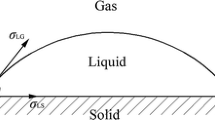Abstract
The properties and thickness of the bubbles in the froth control the flotation process. There is no work showing how to measure bubble film composition and thickness by a straightforward manner. In this work, a novel approach, a custom-designed bubble cell associated with layer interferometry (in the UV-vis region) and FT-IR spectroscopy was used to investigate the effect of solid particle type (hydrophilic vs hydrophobic), concentration and bubble diameter on stability of a bubble blown in air. Stability was quantified by measuring bubble lifetime and hydrated film thickness. Kerosene with silicone oil as a foaming agent was used to evaluate the impact of bubble diameter (test series I). Frother solutions (MIBC, Dowfroth 250, Hexanol and F-150) were used for the solid type concentration experiments (test series II). In the first series of experiments, it was determined that as the diameter of a bubble increased from 10 to 25 mm, so did the hydrated film thickness from 350 to 1000 nm. In the second series, as the silica concentration increased (0 to 10%), an increase in bubble lifetime and hydrated film thickness was resulted (130%–250%). An impact of solid hydrophobicity was found but to a lesser degree than expected. It is possible that the small particle size (<0.1 m) of silica was responsible for this behavior. The findings are used to interpret the effect of solids in flotation froth.
Similar content being viewed by others
References
HU Yue-hua, MENG Xiang-li, SUN Wei. A novel quantificational assessment method of frothers effect on bubble characteristics [J]. Journal of Central South University of Technology, 2011, 18: 1910–1916.
ZHANG Wei, ZHU S, FINCH J A. Frother partitioning in dual-frother systems: Development of analytical technique [J]. International Journal of Mineral Processing, 2013, 119: 75–82.
ZHANG Wei, NESSET J E, FINCH J A. Water recovery and bubble surface area flux in flotation [J]. Canadian Metallurgical Quarterly, 2010, 49(4): 353–362.
PUGH R J, WEISSENBORN P, PAULSON O. Flotation in inorganic electrolytes: The relationship between recovery of hydrophobic particles, surface tension, bubble coalescence and gas solubility [J]. International Journal of Mineral Processing, 1997, 51: 125–138.
KITCHENER J A, COOPER C F. Current concepts in the theory of foaming [J]. Quarterly Review, 1959, 13: 71–79.
HUNTER T N, PUGH R J, FRANKS G V, JAMESON G J. The role of particle in stabilising foams and emulsions [J]. Advances in Colloid and Interface Science, 2008, 137(2): 57–81.
BLUTE I, PUGH R J, VAN DE PAS J, CALLAGHAN I. Industrial manufactured silica nanoparticle sols. 2: Surface tension, particle concentration, foam generation and stability [J]. Colloids and Surfaces A: Physicochemical and Engineering Aspects, 2009, 337(1/2/3): 127–135.
SHKODIN A M, TIKHOMIVOVA G P. Frothing in mixtures of surface-active colloids [J]. Colloid Journal (Moscow), 1951, 13, 34–37.
ATA S, AHMED N, JAMESON G J. Collection of hydrophobic particles in the froth phase [J]. International Journal of Mineral Processing, 2002, 64: 101–122.
ZHANG Wei, KOLAHDOOZAN M, NESSET J E, FINCH J A. Use of frother with sampling-for-imaging bubble sizing technique [J]. Minerals Engineering, 2009, 22(5): 513–515.
ZHANG Wei, ZHOU X, FINCH J A. Determining independent control of dual-frother systems — gas holdup, bubble size and water overflow rate [J]. Minerals Engineering, 2012, 39: 106–116.
HUIBERS P, SHAH D O. Multispectral determination of soap film thickness [J]. Langmuir, 1997, 13: 5995–5998.
SARMA T K, CHATTOPADHYAY A. Simultaneous measurement of flowing fluid layer and film thickness of a soap bubble using a UV-visible spectrophotometer [J]. Langmuir, 2001, 17: 6399–6403.
PRUD’HOMME R K, KHAN S A. Foams-theory, measurements, and applications [M]. New York: Marcel Dekker, 1995: 281–287.
ZHANG Wei, NESSET J E, RAO S R, FINCH J A. Characterizing frothers through critical coalescence concentration (CCC95)-hydrophilic-lipophilic balance (HLB) [J]. Minerals, 2012, 2(3): 208–227.
GELINAS S, FINCH J A, GOUET-KAPLAN M. Comparative real-time characterization of frother bubble thin films [J]. Journal of Colloid and Interface Science, 2005, 291: 187–191.
DIPPENAAR A. The destabilization of froth by solids I: the mechanism of film rupture [J]. International Journal of Mineral Processing, 1982, 9: 1–14.
JOHANSSON J, PUGH R J. The influence of particle size and hydropohobicity on the stability of mineralized froths [J]. International Journal of Mineral Processing, 1992, 34: 1–21.
TAO D. Role of bubble size in flotation of coarse and fine particles-a review [J]. Separation Science and Technology, 2004, 39(4): 741–760.
Author information
Authors and Affiliations
Corresponding author
Additional information
Foundation item: Project(2013BAB14B05) supported by National Key Technology Research and Development Program of the Ministry of Science and Technology of China
Rights and permissions
About this article
Cite this article
Liu, HJ., Zhang, W. & Sun, CB. Influence of bubble diameter and solids concentration on bubble stability: Development of a novel analytical approach. J. Cent. South Univ. 21, 3588–3595 (2014). https://doi.org/10.1007/s11771-014-2340-6
Received:
Accepted:
Published:
Issue Date:
DOI: https://doi.org/10.1007/s11771-014-2340-6




